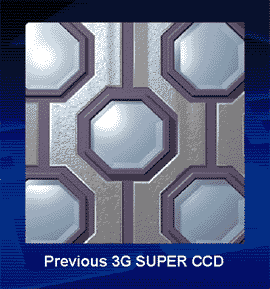Fuji adds further innovations to its Super CCD | |||||
By Ian Burley | |||||
Fujifilm’s 4th Generation Super CCDs
Super CCD SR - ‘HiFi’ digital imaging?Fujifilm says its forthcoming high-end cameras will work in conditions that currently defeat most digital cameras - in bright and contrasty scenes. How will it achieve this feat? Look at a typical HiFi speaker. It has a ‘woofer’ unit for low to mid-frequency sounds and a ‘tweeter’ for high frequency sounds. Fujifilm has made the inspired move to adapt this concept to digital camera imaging with the announcement today of Super CCD SR. The new Super CCD SR, like existing Fujifilm Super CCD sensors, has the conventional columnar array of photodiodes turned by 45 degrees and the sensor data is interpolated (Since this story was pubished our friendly contacts at Fujifilm UK have stressed to us that the term ‘interpolation’ doesn’t do their technology justice! -Ed) to produce a conventional image file. This arrangement of the photodiodes is often compared to a honeycomb, though bee ‘cells’ are six-sided, whereas Fujifilm represents the Super CCD graphically with eight-sided sensor sites.
But the big difference with the SR-series Super CCD is that each octagonal sensor site now has two photodiodes instead of one. One is analogous to the speaker woofer and the other, the tweeter.
One photodiode, or the primary photodiode, is optimised to gather information about light intensities in the usual range for a digital camera CCD. The second, or secondary, photodiode, is deliberately less sensitive and is designed to capture part of the highlight luminance that would normally be lost in blown or burned out areas of an image. With this neat trick, Fujifilm says Super CCD SR-equipped cameras will deliver much better tonal and dynamic range, especially in regions where bright highlights occur. The company points out that its experience in conventional silver halide colour film formulations was instrumental in the development of the Super CCD SR concept.
How much better will images from Super CCD SR-equipped cameras be? That we won’t know until the first Fujifilm cameras sporting the new sensors arrive. Fujifilm says a product announcement will be made before the big PMA show in Las Vegas in the first week of March.
However, don’t expect the first cameras to use Super CCD SR chips to be budget models. Fujifilm confirms that Super CCD SR will start life housed in a high-end model. The first Super CCD SR chip will have 3.1 million photo-sites, numbering a total of 6.2 million sensors (half primary and half secondary). It will output up to 6 million image pixels. Super CCD HR - smaller sensors for smaller cameras but without sacrificing resolutionA far less glamorous revelation than its ‘SR’ sibling, the new Super CCD HR (High Resolution) is a direct refinement of the existing third-generation Fujifilm Super CCD. To make very compact digicams, you need very small sensor chips. The smaller these get, the harder it is to maintain quality and resolution. Problems include increased noise and decreased sensitivity. Fujifilm says its HR-series chips avoid the accompanying problems of miniaturisation through advanced research and development in fabrication methods. The first of the two sensors will be a 1/2.7” (9.4 mm) size sensor with an effective resolution of 3.1 million pixels, and an output resolution of 6 million pixels. Competing CCDs of this size are usually limited to between 2-3 megapixel outputs. The second sensor is a 1/1.7” (14.9 mm) sensor featuring an effective resolution of 6 million pixels, with an output resolution of 12 million pixels. Conventional CCDs of this size, or even slightly larger are currently limited to 5 megapixels. Super CCD HR models will be found be mid to high end camera models and again, news of such new models will be available before this year’s PMA show at the beginning of March. Super CCD SR press release text | |||||
| |||||
| Feedback | Main news page | Discussion forum | Newsletter | | |||||
DPN News service
www.dp-now.com
 Add new innovation to an already innovative product and you have Fujifilm’s new Super CCD SR that uses two photodiodes where everyone else uses just one. Plus,
Add new innovation to an already innovative product and you have Fujifilm’s new Super CCD SR that uses two photodiodes where everyone else uses just one. Plus, 



